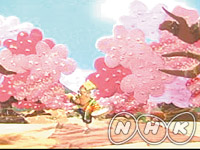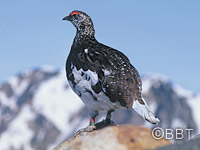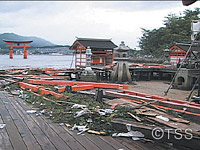Production Year 2008
 Théâtre de marionnettes | Furuya no Mori – Monstre ou fuite d’eau?
Théâtre de marionnettes | Furuya no Mori – Monstre ou fuite d’eau?
CH710801![]()
ふるやのもり [NHK]
![]()
![]()

|Length : 15min. |Year : 2008 |
C'est avec l'intention de voler un cheval qu'un loup et un voleur s'infiltrent sur une propriété ou se trouve une maison et une écurie. Le couple agé qui y vit raconte à leur petit fils l'histoire de furuya no mori, une créature féroce, la plus féroce du monde entier, qui ne sort de chez lui que lors de nuits noires et pluvieuses. Le voleur épouvanté par l'histoire, tombe du loft et atterrit sur le loup qui lui s'était dissimulé près de la stalle du cheval. Toute une commotion s'ensuit quand le voleur et le loup pensent tous deux qu'ils sont aux prises avec l'effrayant furuya no mori quand en fait furuya no mori c'est une vieille maison dont le toit coule et qui est sur le point de s'effondrer.
 Théâtre de marionnettes | Le vieillard qui faisait fleurir les arbres
Théâtre de marionnettes | Le vieillard qui faisait fleurir les arbres
CH710802![]()
はなさかじいさん [NHK]
![]()
![]()

|Length : 15min. |Year : 2008 |
Un gentil mais pauvre fermier et sa femme se portent à la rescousse d'un petit chien nommé Shiro. Pour le remercier Shiro mène le vieil homme à une cache où est enterré une fortune en pièces d'or. Quand Shiro trépasse, le vieux couple l'enterre dans un coin de leur champ et marquent l'endroit avec un plantule de pin. Miraculeusement ce petit arbre se transforme en un géant au cours de la nuit. Le vieux fermier se sert du bois de cet arbre pour fabriquer un pilon pour battre les galettes de riz. Un autre miracle se produit : des pièces d'or se matérialisent chaque fois qu'il utilise le pilon. Un jour ce pilon miraculeux – souvenir de Shiro – est détruit par le feu. Il ne reste que des cendres. Le vieux fermier répand les cendres dans le vent et soudainement, les arbres dénudés se couvrent de fleurs.
Ptarmigans “living in the peaks of the Tateyamas”
DC210827![]()
ライチョウ ~立山に生きる~ [BBT]
![]()
![]()

|Length : 41min. |Year : 2008 |
Murodo, which is located at the foot of the peaks of the Tateyamas in the North Alps, with mountains in the 3,000 high-class, is the area where the habitation density of the ptarmigan is the highest in Japan. Various dramas are developed there every season, such as males' fight over the territory, intent courtship behavior, birth of baby birds, mothers' child-care, molting to become the wonderful protective coloration and so on.
The mysterious bird which was left behind in the alpine belt of island Japan in the end of the glacial epoch. This is the nature-interest document which stared at the one year of the ptarmigans to survive powerfully in Murododaira, Tateyama, which is 2,450 meters above the sea and covered with snow for more than half a year.
Save Our Treasure! – The 278-day Restoration of Itsukushima Shrine –
DC270828![]()
守れ!海に浮かぶ朱の宝 ~厳島神社修復278日~ [TSS]
![]()
![]()

|Length : 46min. |Year : 2008 |
UNESCO World Heritage Itsukushima Shrine suffered extensive damages from a typhoon that struck in the autumn of 2004. "Save Our Treasure!" depicts Japanese workmen displaying traditional expertise as they endeavor to revive the globally unparalleled wooden structure on the sea, while local middle school students take up a number of activities in hopes of rediscovering the history on which they stand. The hearts of the people shine through in this struggle with natural disaster, to save the island's cultural heritage.
Kyoto : A Tale of Ancient Gardens – Part 1
DC270829![]()
京都・庭の物語 ~千年の古都が育んだ空間美~ (前編) [NHK]
![]()
![]()

|Length : 50min. |Year : 2008 |
Japanese gardens embody the Japanese aesthetic. This program introduces a number of Kyoto gardens including those of Kinkakuji, Ryoanji, Daikakuji, Byodoin, and Tenryuji. temples. Impressive high-definition images will show the changing faces of these seasonal gardens. Join us as we journey through these ancient gardens and delve into the profound meanings behind them. Discover how "dry gardens" retain the beauty of a simple stone and see how emperors, warlords, nobles, and priests all took part in the creation of these magnificent gardens.














